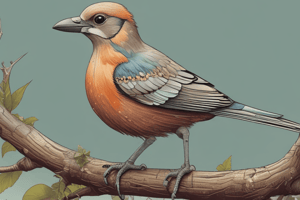Podcast
Questions and Answers
What is a characteristic of birds that provides insulation, support, and protection?
What is a characteristic of birds that provides insulation, support, and protection?
- Beak
- Feathers (correct)
- Hollow Bones
- Wings
What is the function of a bird's beak?
What is the function of a bird's beak?
- Eating, preening, and other functions (correct)
- Walking
- Breathing
- Flying
Which type of bird has adapted to aquatic environments?
Which type of bird has adapted to aquatic environments?
- Waterbirds (correct)
- Birds of Prey
- Songbirds
- Flightless Birds
What is a behavior exhibited by birds like starlings and sandpipers?
What is a behavior exhibited by birds like starlings and sandpipers?
Why do many birds migrate?
Why do many birds migrate?
When did birds evolve from theropod dinosaurs?
When did birds evolve from theropod dinosaurs?
Approximately how many species of birds exist?
Approximately how many species of birds exist?
What has enabled birds to thrive in almost every environment on Earth?
What has enabled birds to thrive in almost every environment on Earth?
Flashcards are hidden until you start studying
Study Notes
Characteristics of Birds
- Feathers: Birds are covered in feathers, which provide insulation, support, and protection.
- Wings: Birds have wings, which are actually modified forelimbs.
- Hollow Bones: Birds have hollow bones, which makes them lighter and more efficient for flight.
- Lightweight Skeleton: Birds have a lightweight skeleton, which helps reduce their overall weight.
- Beak: Birds have a beak, which is a hard, keratin-based mouthpart used for eating, preening, and other functions.
Body Types and Adaptations
- Flightless Birds: Some birds, like penguins and ostriches, have lost the ability to fly due to evolutionary adaptations to their environment.
- Waterbirds: Birds like ducks and geese have adapted to aquatic environments, with features like webbed feet and water-repellent feathers.
- Songbirds: Songbirds have adapted to sing complex songs to attract mates and defend territories.
- Birds of Prey: Birds of prey, like hawks and eagles, have adapted to hunt and kill small animals, with features like sharp talons and exceptional eyesight.
Behavior and Migration
- Migration: Many birds migrate to find food, escape harsh weather, or breed.
- Flocking: Some birds, like starlings and sandpipers, flock together for protection, foraging, and social interaction.
- Courtship and Mating: Birds have complex courtship and mating behaviors, often involving elaborate displays and songs.
- Nesting and Incubation: Birds build nests and incubate eggs, often with both parents contributing to care and protection.
Evolution and Diversity
- Origin: Birds evolved from theropod dinosaurs during the Jurassic period, around 150 million years ago.
- Diversity: There are over 10,000 different species of birds, ranging in size, shape, color, and behavior.
- Adaptation: Birds have adapted to almost every environment on Earth, from the frozen tundra to the hottest deserts.
Characteristics of Birds
- Birds are covered in feathers, which provide insulation, support, and protection, and are made of a tough, yet lightweight protein called keratin.
- Birds have wings, which are actually modified forelimbs, made up of three bones: the humerus, radius, and ulna.
- Hollow bones make up the bird's skeleton, which makes them lighter and more efficient for flight.
- Birds have a lightweight skeleton, which helps reduce their overall weight and allows for flight.
- Birds have a beak, which is a hard, keratin-based mouthpart used for eating, preening, and other functions.
Body Types and Adaptations
- Flightless birds, like penguins and ostriches, have lost the ability to fly due to evolutionary adaptations to their environment.
- Waterbirds, like ducks and geese, have adapted to aquatic environments, with features like webbed feet and water-repellent feathers.
- Songbirds have adapted to sing complex songs to attract mates and defend territories.
- Birds of prey, like hawks and eagles, have adapted to hunt and kill small animals, with features like sharp talons and exceptional eyesight.
Behavior and Migration
- Migration is a common behavior among birds, with many species migrating to find food, escape harsh weather, or breed.
- Flocking is a behavior seen in some birds, like starlings and sandpipers, where they gather together for protection, foraging, and social interaction.
- Courtship and mating behaviors in birds are complex and often involve elaborate displays and songs.
- Nesting and incubation are critical behaviors in birds, where they build nests and incubate eggs, often with both parents contributing to care and protection.
Evolution and Diversity
- Birds evolved from theropod dinosaurs during the Jurassic period, around 150 million years ago.
- There are over 10,000 different species of birds, ranging in size, shape, color, and behavior.
- Birds have adapted to almost every environment on Earth, from the frozen tundra to the hottest deserts.
Studying That Suits You
Use AI to generate personalized quizzes and flashcards to suit your learning preferences.




